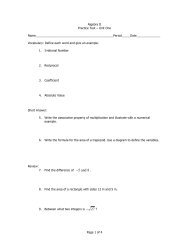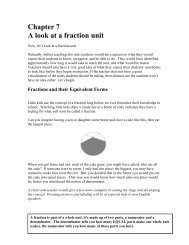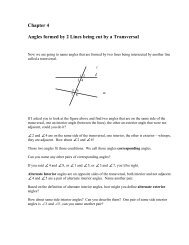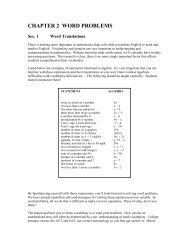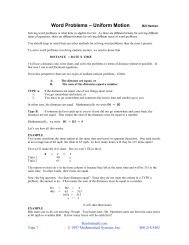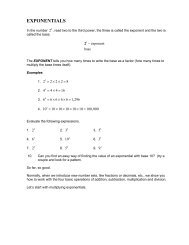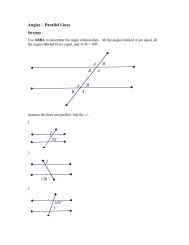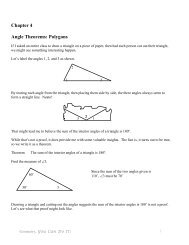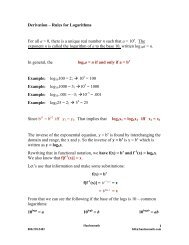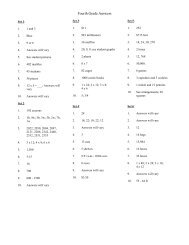Chapter 4 Relations and Functions - Hanlon Math
Chapter 4 Relations and Functions - Hanlon Math
Chapter 4 Relations and Functions - Hanlon Math
You also want an ePaper? Increase the reach of your titles
YUMPU automatically turns print PDFs into web optimized ePapers that Google loves.
Now, if I plug 2 into that function, I get 4, just like I did before.<br />
(f + g) (x) = 4x – 4<br />
What we can see from this example is I can find the value of f(2) <strong>and</strong> the value of g(2) <strong>and</strong> add those<br />
two results together to find an answer or I could have combined f <strong>and</strong> g first into one rule, then found<br />
(f+g)(2). The answer is the same.<br />
You see that it works. <strong>Math</strong> = your life.<br />
While you may be wondering why someone might want to even bother with this, later it will help us in<br />
our graphing <strong>and</strong> save us some time computationally. By combining rules as we did with f <strong>and</strong> g, we<br />
can cut our work down considerable – particularly if we had a lot of computations to do.<br />
Sec. 3<br />
Composition of <strong>Functions</strong><br />
There are times when we may not want only to add or subtract functions as we just did, but compose a<br />
new function because the data we substitute in the first will be used to find the result of a second<br />
function.<br />
For instance, let’s say you are billed for your cell phone at a rate described by the following function<br />
(rule).<br />
C = 0.05x + 10<br />
In other words the cost of your cell phone is $10.00 per month plus five cents for each minute you<br />
speak.<br />
Let’s suppose you spoke for twenty minutes, you would be billed $11.00 for the month.<br />
Now, let’s say you are taxed at 8% on that amount <strong>and</strong> that is added to your bill. Well, that’s easy<br />
enough, I find the cost of the cell phone, take 8% of that number <strong>and</strong> add that sum to the bill. In our<br />
case, 8% of $11.00 is $0.88. So our bill is $11.88.<br />
Now, if I had one thous<strong>and</strong> customers <strong>and</strong> I wanted to to find their monthly tax bill. To accomplish<br />
that, I would have to find the monthly charge, then take 8%. While that’s not hard work, there’s two<br />
steps of computation that have to be completed.<br />
Wouldn’t it be nice if I could find a way of combining those functions into one rule – eliminating one of<br />
the computations?<br />
Let’s rewrite these two rules using mathematical notation. We’ll let f describe the cost of the cell phone<br />
as previously described:<br />
f(x) = 0.05x + 10<br />
And g describe the amount of tax to be paid based upon that bill.





